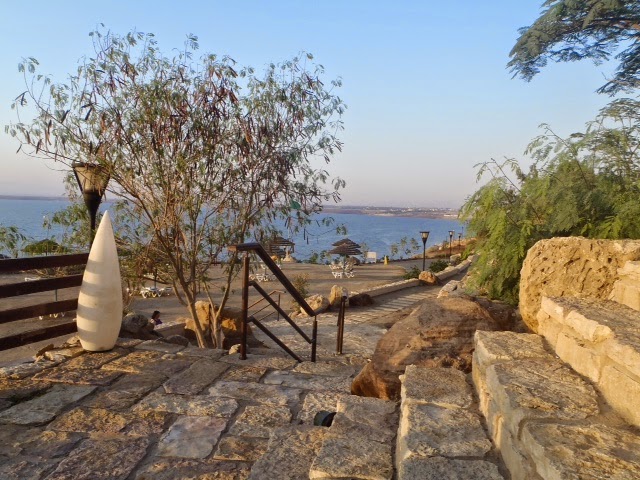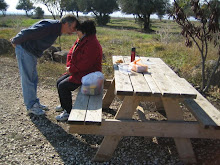We have been to Jordan a number of times
over the past few years to visit family – lucky us! In previous blog posts we have
shown the yummy food we’ve enjoyed (a few more here)
as well as places of interest, including Petra, Aqaba and Wadi Rumm - see 2011 posts.
In this blog we feature some more aspects of this fascinating country and take you on an extended tour of a museum showing the history of this part of the world – one of the best exhibitions that I have been to.
as well as places of interest, including Petra, Aqaba and Wadi Rumm - see 2011 posts.
In this blog we feature some more aspects of this fascinating country and take you on an extended tour of a museum showing the history of this part of the world – one of the best exhibitions that I have been to.
But let’s start with something quite
different. In Jordan there is a sizeable number of gypsies, who travel from
place-to-place according to the seasons – living in tents without direct access
to electricity, water or sanitation. They rely upon the generosity of people in
the neighbourhood to provide water, which they carry back to their tents in 20
litre containers, and scout building sites for discarded timber in order to
cook and keep warm.
Two groups were camped in our neighbourhood
– and several others in surrounding suburbs. This is a typical gypsy camp with
a couple of families living together in six tents. This photo was taken from the kitchen window of Muna's family.
This family lived quite alone on a hillside
facing the newly constructed airport freeway – along with their camels.
Some other photos of our neighbourhood show
how rocky this soil is – and yet with water it yields abundant crops.
Most people live in apartments, but in
certain areas large houses with extensive gardens can be found.
One owner keeps his own herd of camels
And this one protects his house with a nifty cannon:
Sunsets are beautiful when there are clouds in the sky.
And this one protects his house with a nifty cannon:
Sunsets are beautiful when there are clouds in the sky.
There are a lot of very poor people living
in Jordan – including over a million refugees from the current conflict in
Syria and another million from other recent conflicts/revolutions in the Middle
East, like Iraq and Egypt. This is placing a lot of pressure on the availability
of water, food and accommodation. The cost of living has, therefore, increased significantly
in recent years. A lot of educated Jordanians live and work in other Arab
countries of the Gulf region, and apart from a large number of cars with Syrian
registration, it is not uncommon to see cars from the Emirates (Dubai and Abou
Dhabi), Kuwait and Saudi Arabia.
It was very apparent that Amman was in the midst of a construction boom, with apartments going up everywhere you look. The population is expected to double in the next few decades.
Now to the museum, which is located on the outskirts of Madaba, near Mount Nebo, from where Moses showed the Jews the Promised Land; of course he died in Jordan and did not cross over to the Holy Land.
Now to the museum, which is located on the outskirts of Madaba, near Mount Nebo, from where Moses showed the Jews the Promised Land; of course he died in Jordan and did not cross over to the Holy Land.
This museum called “Hikayah” (story) was
opened just a year ago (2013) and was conceived by the local Madaba youth, who also
carried out most of the work; it is also mechanised (lots of moving parts,
especially in the final section) which greatly adds to its charm. This is the countryside surrounding the museum:
The first section portrays stories from biblical times, starting with Noah’s Ark and the Tower of Babel (Babylon)
Covers Moses in Egypt and leading the Israelites to the Promised Land
The first section portrays stories from biblical times, starting with Noah’s Ark and the Tower of Babel (Babylon)
Covers Moses in Egypt and leading the Israelites to the Promised Land
as well as the life of Jesus
and finishes with the last supper.
Historical landmarks of the region are
shown in the next section. Here is Petra:
Dome of the Rock in Jerusalem
Prophet Muhammad's mosque and tomb in Medina
the Kaaba in Mecca
More modern history and the lifestyle of
the Bedouins have been recreated faithfully
The final section was truly fascinating –
scenes of the many small shops that were, and still are, a significant part of
the commercial enterprise of Jordanian towns. Muna and her family remember
shops just like this from their childhood, and that would have been the norm
for her parents’ generation (though today’s small corner stores have a fridge
with bottled water and soft drinks). Everything from bakers and carpenters to
Turkish baths and schools. Enjoy!
Here a street urchin peeks out from under a road cover:
and finally a lovely example of the wooden windows that were prevalent.
These are just a taste of what you will see.
Muna and I were fortunate to participate in a number of classes for youth and adults. Most of the family and friends speak English and it was a real joy to have these meaningful discussions.
Muna and I were fortunate to participate in a number of classes for youth and adults. Most of the family and friends speak English and it was a real joy to have these meaningful discussions.
We had a perfect ending to our visit – 2 days
in a fancy resort at the Dead Sea. Balmy weather, beautiful pools and
immaculate grounds and gardens cascading down to the edge of this ancient sea
with the most relaxing warm salty waters. And, nice food and company – absolute
bliss!
So, what delights await us when we visit next year? We will just have to wait and see – inshallah (God willing) !!!
So, what delights await us when we visit next year? We will just have to wait and see – inshallah (God willing) !!!























































